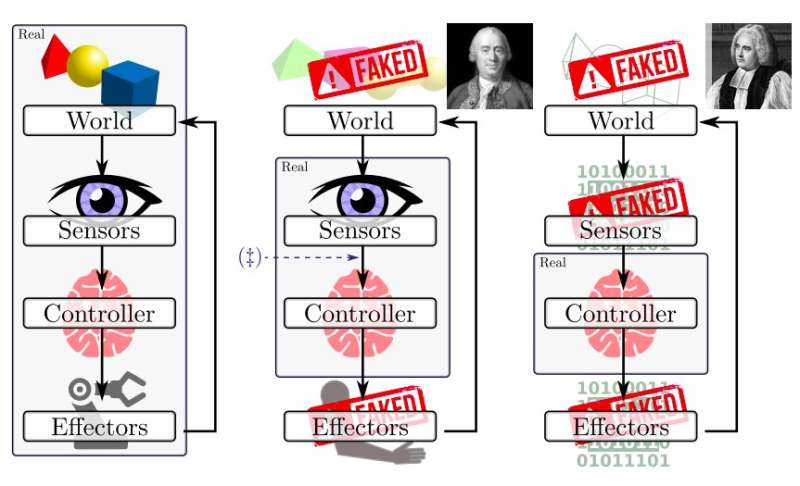An illustration of different modes of fakery matched with appropriate intellectual positions: the orthodox view (left) and two forms of philosophical skepticism (center and right). The left column represents an end-to-end physical robot experiment with every part being real. The middle column, bearing the bust of David Hume, involves real sensors but also reason to doubt the veracity of the world they report. The rightmost column, headed by Bishop Berkeley, has a real controller but all other elements are mere software—it represents a robot experiment conducted in simulation (for the commonplace use of that term) where information is injected directly into the robot’s cortex. Hume’s column is the case studied in the paper: robots perceive a world mediated by sensors that are grounded in the real world, but it is a world of ‘nothing but sophistry and illusion.’ Credit: Shell & O’Kane.
To evaluate the performance of robotics algorithms and controllers, researchers typically use software simulations or real physical robots. While these may appear as two distinct evaluation strategies, there is a whole other range of possibilities that combine elements of both.
In a recent study, researchers at Texas A&M University and the University of South Carolina have set out to examine evaluation and execution scenarios that lie at an intersection between simulations and real implementations. Their investigation, outlined in a paper pre-published on arXiv, specifically focuses on instances in which real robots perceive the world via their sensors, where the environment they sense could be seen as a mere illusion.
"We consider problems in which robots conspire to present a view of the world that differs from reality," Dylan Shell and Jason O'Kane, the researchers who carried out the study, wrote in their paper. "The inquiry is motivated by the problem of validating robot behavior physically despite there being a discrepancy between the robots we have at hand and those we wish to study, or the environment for testing that is available versus that which is desired, or other potential mismatches in this vein."
The study draws inspiration from previous biological research, which was aimed at understanding the perceptual limitations of living organisms and how informational mismatches can affect their behavior. In recent years, biologists have started using technological tools such as virtual reality (VR) and augmented reality (AR) to gain a better understanding of biological organisms and their perceptions.
Similarly, software simulations have become a key component of robotics research, with many researchers using them to execute and test their robotic systems and approaches. In most of these cases, a simulation software reproduces some elements of a robot's execution in a virtual, rather than physical, environment, generating artificial sensor readings or state-related data.
This poses another question: How closely does a simulator, which is a system in itself, actually reproduce the real world? With this in mind, the researchers set out to explore the relationships between pairs of systems that "match each other," as well as instances in which one of these systems is powerful enough to conjure an illusion on the other.
"After formulating the concept of a convincing illusion, essentially a notion of system simulation that takes place in the real world, we examine the implications of this type of simulability in terms of infrastructure requirements," Shell and O'Kane explained in their paper. "Time is one important resource: some robots may be able to simulate others but, perhaps, only at a rate that is slower than real-time."
Shell and O'Kane suggest that the different rates at which systems can simulate other systems allow researchers to describe simulating and simulated systems in a relative form. Based on this assumption, they developed some theorems to outline the relation between a simulating and a simulated system, offering several examples for each one.
Subsequently, the researchers carried out a simple multi-robot experiment based on the theory they developed. In this experiment, a robot had to complete a simple navigation task in an unbounded field of obstacles, both in simulation and on a physical robot testbed. Their findings suggest that different simulation approaches can have markedly different time efficiencies in producing an illusion for a given system.
The observations gathered by Shell and O'Kane, as well as the theory they developed, could broaden the current understanding of simulation software used to evaluate robotics approaches, highlighting new aspects of the relationship between simulated and simulating systems. In their future work, they could explore a variety of new research directions, for instance extending their theory to address the notions of uncertainty and non-determinism or developing a richer theory of efficient illusions.
More information: Reality as a simulation of reality: robot illusions, fundamental limits, and a physical demonstration. arXiv:1909.03584 [cs.RO]. arxiv.org/abs/1909.03584
© 2019 Science X Network
























